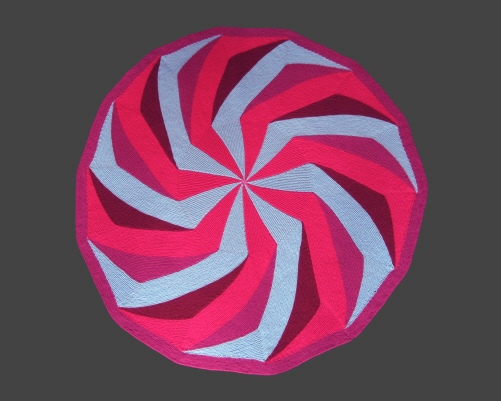




I love the numbers that make this work even more than I like the idea that inspired it. It defies mathematical logic but works because the knitting is able to just do its own thing, stretching and bending where it wants, in order to lie flat.
It is based on the properties of ‘shapes of constant width’. These are well-
The simplest shape of constant width is the Reuleaux triangle. It was named after
a German engineer, in the late nineteenth century, though the concept pre-
In November 2013 we went again to MathsJam and I was again inspired by Joel Haddley.
He is rather more of an academic than I am but the shapes he deals with are very
interesting from my geometer’s point of view. Money Spinner literally evolved from
a back-
He took a 50p coin and drew round it, then moved it and drew round it again. He kept
doing this until he had a ‘circle’ of shapes, a bit like you might get in a Spirograph
pattern. By missing out part of each drawing it was clear to see that there were
14 identical shapes, each with seven curved sides. Because the sides of the original
coin are all the same length, it is self-
In knitting terms, to make the sides of a shape equal they must have the same number
of stitches. My first attempts at knitting the shapes were the kind of thing that
is likely to drive you mad. I seemed to be working inside-
The numbers are delightful but, mathematically, completely and utterly wrong! There is only one number you use, and work towards, at any point in the knitting. This means the size can be adjusted because that number can be anything you want it to be.
For the mathematician the numbers don’t make any sense. For a more interesting visual
effect, I chose to add some extra lines within the original shapes to create triangles
but these did not change any of the dimensions. If the triangle is described as ABC,
side AB has the same number of stitches as side BC. Strangely, the other side has
the same number of stitches as AB + BC. Under other circumstances, these dimensions
could not possibly create a triangle -
This afghan was also interesting because we had previously worked with 3, 4, 6 and
8-
